Whistler Blackcomb is a ski resort located in Whistler, British Columbia, Canada. By many measures it is the largest ski resort in North America and has the greatest uphill lift capacity. It features the Peak 2 Peak Gondola for moving between Whistler and Blackcomb mountains at the top. With all of this capacity, Whistler Blackcomb is also often the busiest ski resort, often surpassing 2 million visitors a year.

Mount Seymour is a mountain located in Mount Seymour Provincial Park in the District of North Vancouver, British Columbia, Canada. It is a part of the North Shore Mountains, rising to the north from the shores of Burrard Inlet and Indian Arm to a summit of 1,449 m (4,754 ft) above the Indian River and Deep Cove neighbourhoods. Mount Seymour is most commonly identified for its ski area of the same name, and as a popular hiking area. It is named in honour of Frederick Seymour, second governor of the Colony of British Columbia. The name is used to refer to the ridge although the main summit is one of several, and is also known as Third Peak.
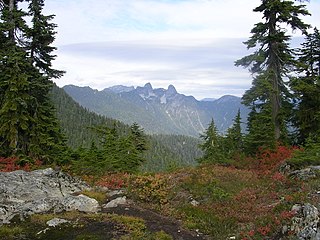
Cypress Provincial Park is a provincial park on the North Shore of Metro Vancouver Regional District, British Columbia. The park has two sections: a 21 km2 (8.1 sq mi) southern section which is accessible by road from West Vancouver, and a 9 km2 (3.5 sq mi) northern section which is only accessible by hiking trails. The two sections are linked by a narrow strip of park along the mountainous Howe Sound Crest Trail.

Mountain Creek is a ski resort in Vernon Township, Sussex County, New Jersey, United States. It is located on New Jersey Route 94 in the New York Metropolitan Area, 47 miles (76 km) from the George Washington Bridge.

Cypress Mountain is a ski area in West Vancouver, British Columbia, Canada, located in the southern section of Cypress Provincial Park, operated under a BC Parks Park Use Permit.
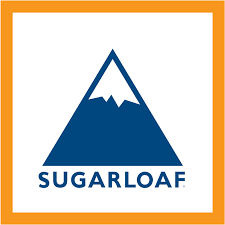
Sugarloaf is a ski area and resort located on Sugarloaf Mountain in Carrabassett Valley, western Maine. It is the second largest ski resort east of the Mississippi in terms of skiable area and snowmaking percentage (95%); its continuous vertical drop of 2,820 feet (860 m) is the second longest in New England. Sugarloaf recorded a total of 352,000 skier visits in the 2005–2006 season, ranking it second among Maine resorts and 11th in New England.

Sun Peaks Resort is an alpine ski resort located in Sun Peaks, British Columbia, Canada, 56 km (35 mi) northeast of Kamloops.
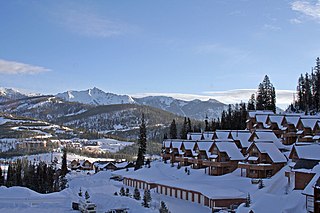
Big Sky Resort is a ski resort in the western United States, located in southwestern Montana in Madison County. An hour south of Bozeman via U.S. Highway 191 in Big Sky, Montana, it is the second-largest ski resort in the United States by acreage after Palisades Tahoe.
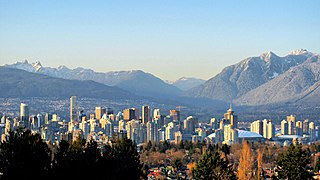
The North Shore Mountains are a mountain range overlooking Vancouver in British Columbia, Canada. Their southernmost peaks are visible from most areas in Vancouver and form a distinctive backdrop for the city.

Blue Mountain is an alpine ski resort in Ontario, Canada, 10 km west of Collingwood. It is situated on a section of the Niagara Escarpment about 1 km (0.6 mi.) from Nottawasaga Bay, and is a major destination for skiers from southern Ontario. The local area forms the newly incorporated town of The Blue Mountains, Ontario. On average, Blue Mountain sells more than 750,000 lift tickets per year, making it the third-busiest ski resort in Canada, after Whistler-Blackcomb in British Columbia and Mont Tremblant in Quebec. It is one of the largest resorts in Ontario and has been extensively built out, featuring 42 runs, 16 chairlifts and 3 freestyle terrains.

Sugarbush Resort is a ski resort located in the Mad River valley in Warren, Vermont, owned by Alterra Mountain Company. It is one of the largest ski resorts in New England. The resort encompasses more than 4000 acres (16 km²) total, 484 trail acres (2.34 km²) skiable, 53 miles (85 km) of trails, and 16 ski lifts. Sugarbush has 111 ski trails, 18 additional marked wooded area, substantial off-piste skiing and riding, a summit elevation of 4,083 ft (1,244 m), and a vertical drop of 2,600 feet (790 m), second largest in Vermont after Killington, and the third largest in New England after Killington and Sugarloaf.

June Mountain ski area is a winter resort in the eastern Sierra Nevada of California, located near June Lake, southeast of Yosemite National Park.

Park City Mountain Resort (PCMR) is a ski resort in the western United States in Park City, Utah, located 32 miles (51 km) east of Salt Lake City. Park City, as the ski resort and area is known, contains several training courses for the U.S. Ski Team, including slalom and giant slalom runs. During the 2002 Winter Olympics, it hosted the snowboarding events and the men's and women's alpine giant slalom events.

Crystal Mountain is a mountain and alpine ski area in eastern Pierce County, Washington, United States, located in the Cascade Range southeast of Seattle. It is the largest ski resort in the state of Washington and lies within the Mount Baker–Snoqualmie National Forest. The resort is accessible from the Seattle–Tacoma metropolitan area via State Route 410.

Breckenridge Ski Resort is an alpine ski resort in the western United States, in Breckenridge, Colorado. Recognized for acres of skiable terrain across five mountain peaks, it welcomes thousands of skiers and snowboarders each season. Just west of the Continental Divide in Summit County, it is perennially one of the most visited ski resorts in the western hemisphere. Breckenridge is owned and operated by Vail Resorts, Inc.

Vail Ski Resort is a ski resort in the western United States, located near the town of Vail in Eagle County, Colorado. At 5,289 acres, it is the third-largest single-mountain ski resort in the U.S., behind Big Sky and Park City, featuring seven bowls and intermediate gladed terrain in Blue Sky Basin.

The White Pass Ski Area is a ski area in the Pacific Northwest of the United States, in the Cascade Range at White Pass in the state of Washington. It is located 53 miles (90 km) west of Yakima on U.S. Route 12, and 53 miles (90 km) east of Morton. As the crow flies, the pass is 25 miles (40 km) southeast of the summit of Mount Rainier and 30 miles (50 km) north of Mount Adams.
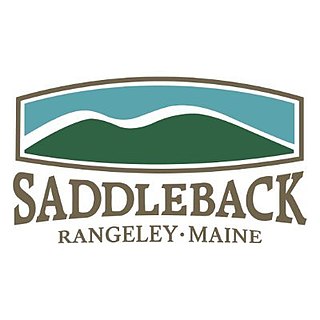
Saddleback Maine is a ski resort located in Sandy River Plantation, near Rangeley, Maine, on the northwestern slopes of Saddleback Mountain. It is the largest independent ski area on the east coast, in terms of number of skiable acres (600). It has (6) lifts, (85%) snowmaking percentage, vertical drop, and skier days. After almost five years of closed doors, Saddleback Mountain was sold to the Arctaris Impact Fund and reopened on December 15, 2020.
Mount Sunapee Resort is a ski area and resort located in Mount Sunapee State Park in Newbury, New Hampshire, United States.

Sandia Peak Ski Area, originally La Madera Ski Area, is a ski resort located in the Sandia Mountains in northeast Bernalillo County, New Mexico, United States, immediately northeast of the city of Albuquerque. It is part of a Special Use Permit Zone in the Sandia Ranger District of the Cibola National Forest. It is New Mexico's first ski area, opening to skiers in 1936. It features Sandia Peak Tramway, which was until 2010 the longest tramway in the world, and remains the longest in the Americas. The resort includes 35 ski runs and a terrain park, and also serves as a site for summer recreation. It is one of the few ski resorts in the US that can be directly accessed from a major city.










































